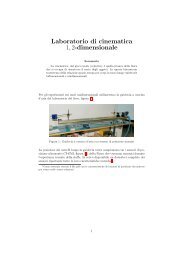Newton's law of cooling revisited - Cartan
Newton's law of cooling revisited - Cartan
Newton's law of cooling revisited - Cartan
Create successful ePaper yourself
Turn your PDF publications into a flip-book with our unique Google optimized e-Paper software.
1066 M Vollmer<br />
Figure 1. Whenever an object is placed in an environment <strong>of</strong> different temperature, there will be<br />
a net energy transfer due to thermal radiation due to emission as well as absorption <strong>of</strong> radiation by<br />
the object.<br />
the current <strong>of</strong> the fluid is due to temperature and, hence, density differences in the fluid. In<br />
forced convection, the current <strong>of</strong> the fluid is due to external forces/pressure. Theoretically,<br />
convective heat transfer is modelled using dimensionless numbers such as the Nusselt number,<br />
the Prandtl number, the Grash<strong>of</strong> number and the Rayleigh number [1]. These depend on the<br />
Reynolds number which defines the kind <strong>of</strong> flow (laminar versus turbulent). Therefrom it<br />
follows that αConv depends on viscosity, thermal conductivity etc and also nonlinearly on the<br />
temperature difference, i.e. αConv ∼ �T x . The exact power x depends on the flow conditions,<br />
e.g. for free convection around a horizontal plate, it changes from x = 0.25 for laminar flow<br />
to 0.33 for turbulent flow [1].<br />
Typical values for free-convective heat-transfer coefficients <strong>of</strong> gases above solids are cited<br />
to range between 2 and 25 W (m 2 K) −1 , the exact value depending on flow conditions, wind<br />
speed and moisture <strong>of</strong> the surface; for liquids they can be in the range 50–1000 W (m 2 K) −1 .<br />
Here, we neglect any effects <strong>of</strong> latent heat associated with convective heat transfer.<br />
2.3. Radiation<br />
The emission <strong>of</strong> thermal radiation by an object is usually expressed as the product <strong>of</strong> a material<br />
property, the emissivity ε and the blackbody radiation due to the object temperature T (e.g.<br />
[1, 2, 27–29]. For many objects (in particular all studied in this work), the emissivity can be<br />
assumed to be independent <strong>of</strong> wavelength, i.e. having a constant value �0.85.<br />
In any realistic situation, an object <strong>of</strong> temperature Tobj is surrounded by other objects<br />
<strong>of</strong> background temperatures Tsurr. For simplicity, we assume an object (figure 1) which is<br />
completely surrounded by an enclosure <strong>of</strong> constant temperature (if the surrounding consists <strong>of</strong><br />
objects with different temperatures, one needs to compute the respective view factors to find<br />
the net radiation transfer [1, 2]).<br />
In addition to the emission <strong>of</strong> radiation from the object there is radiation from the<br />
surroundings incident onto the object. This finally leads to a net energy transfer from the<br />
object with the surface area A to the surroundings<br />
˙QRad = ε · σ · A · � T 4 � 4<br />
obj − Tsurr . (3)<br />
Since any quantitative analysis concerning the heat transfer is much easier for linear<br />
temperature differences, it is customary to approximate the radiative contribution also with




